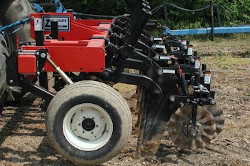By Sjoerd Willem Duiker
In-row subsoiling (also called ‘strip tillage’) can be an alternative to no-tillage if it increases crop yields sufficiently to compensate for the increased expense and does not compromise soil health benefits of continuous no-tillage. Modern subsoilers disturb very little surface residue, don’t invert surface soil, merely fracture the subsoil and, if operated properly, maintain most soil health benefits of continuous no-tillage. However, past research has shown that neither in-row subsoiling nor in-row shallow tillage (aka ‘zone tillage’) increased yields over continuous no-tillage on well-drained soils in Pennsylvania, except where they were severely compacted by heavy equipment. Most soils used for crop production in Pennsylvania are well drained, and on top of that, 60% of our cropland is HEL (Highly Erodible Land). Considering the lack of crop response, the extra expense of subsoiling, the difficulty to find the right time to do it, and the added disturbance (though limited) that does increase soil erosion potential, subsoiling is not commonly practiced.

In-row subsoilers can remediate compaction while providing minimal ground disturbance (Sjoerd Duiker photo).
No-tillage has become very popular, with about 65% of planted acres managed with the practice in Pennsylvania. Nonetheless, we were interested to learn if in-row subsoiling can improve yields on soils with naturally hardened layers at shallow depths. Pennsylvania has large areas (3.2 million acres) of ‘fragipan’ soils. These soils are also common in Mississippi (7.9 million acres), New York (5.7 million acres), Missouri (4.2 million acres), and Kentucky (3.7 million acres). Fragipans have high bulk densities and relatively low clay percentages and become hard when dry, and soft when wet. Management problems of fragipan soils include limitations of rooting depth and slow water percolation. To find roots in fragipans is rare, and we find a seasonally high water table because water percolates very slowly through the fragipan.
We performed in-row subsoiling with an Unferverth subsoiler with two coulters behind each shank on a very poorly drained Andover loam soil in Central Pennsylvania. This soil is found on hillsides in the ridge-and-valley region. It has a 20-inch thick fragipan that starts at about 19 inches depth and lies on a slight slope. The field had been in no-till corn for more than 10 years. We performed subsoiling to a depth of 17 inches every spring for three years and compared the corn yields with those obtained in continuous no-tillage. The soil had good moisture content for subsoiling each spring. No cover crop was grown. The experiment was laid out as a randomized complete block design with four replications.
Corn yields were improved by in-row subsoiling by an average of 14 bushels/A or 11% (Table 1). Yields improved more in years with dry summers (2013 and 2014) than in a moist year (2012). Penetration resistance was measured with a penetrometer just after subsoiling (Figure 1a), and one year later prior to the subsequent subsoiling operation (b), when the soil was at field capacity. Penetration resistance was reduced significantly to a depth of 14 inches in subsoiled plots and was still significantly reduced one year later, suggesting subsoiling may not be necessary every year.
Only about 20% of the soil surface was disturbed by the subsoiling operation, thus soil erosion potential and soil health was minimally impacted compared with continuous no-tillage. In-row subsoiling therefore has potential to improve crop yields significantly on soils with a shallow fragipan. This research was performed in continuous corn and it might be possible to obtain the same results within crop rotations including soybeans or sod. We did not grow a cover crop; we think it is difficult to grow a winter cover crop in a soil with a seasonally high water table, but it might be possible to remediate the subsoil biologically with a cover crop if it could be established early (for example, in September).
Table 1. Subsoiling and no-tillage effects on maize yield (15.5% moisture) on an Andover loam soil with a shallow fragipan.(by year)
Figure 1. Penetration resistance in no-till and subsoiled treatments immediately after (a) and 1 year after (b) subsoiling
Source : psu.edu